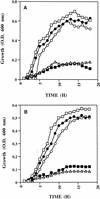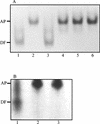Receptor-mediated recognition and uptake of iron from human transferrin by Staphylococcus aureus and Staphylococcus epidermidis
- PMID: 9673237
- PMCID: PMC108390
- DOI: 10.1128/IAI.66.8.3591-3596.1998
Receptor-mediated recognition and uptake of iron from human transferrin by Staphylococcus aureus and Staphylococcus epidermidis
Abstract
Staphylococcus aureus and Staphylococcus epidermidis both recognize and bind the human iron-transporting glycoprotein, transferrin, via a 42-kDa cell surface protein receptor. In an iron-deficient medium, staphylococcal growth can be promoted by the addition of human diferric transferrin but not human apotransferrin. To determine whether the staphylococcal transferrin receptor is involved in the removal of iron from transferrin, we employed 6 M urea-polyacrylamide gel electrophoresis, which separates human transferrin into four forms (diferric, monoferric N-lobe, and monoferric C-lobe transferrin and apotransferrin). S. aureus and S. epidermidis but not Staphylococcus saprophyticus (which lacks the transferrin receptor) converted diferric human transferrin into its apotransferrin form within 30 min. During conversion, iron was removed sequentially from the N lobe and then from the C lobe. Metabolic poisons such as sodium azide and nigericin inhibited the release of iron from human transferrin, indicating that it is an energy-requiring process. To demonstrate that this process is receptor rather than siderophore mediated, we incubated (i) washed staphylococcal cells and (ii) the staphylococcal siderophore, staphyloferrin A, with porcine transferrin, a transferrin species which does not bind to the staphylococcal receptor. While staphyloferrin A removed iron from both human and porcine transferrins, neither S. aureus nor S. epidermidis cells could promote the release of iron from porcine transferrin. In competition binding assays, both native and recombinant N-lobe fragments of human transferrin as well as a naturally occurring human transferrin variant with a mutation in the C-lobe blocked binding of 125I-labelled transferrin. Furthermore, the staphylococci removed iron efficiently from the iron-loaded N-lobe fragment of human transferrin. These data demonstrate that the staphylococci efficiently remove iron from transferrin via a receptor-mediated process and provide evidence to suggest that there is a primary receptor recognition site on the N-lobe of human transferrin.
Figures






Similar articles
-
Staphylococci express a receptor for human transferrin: identification of a 42-kilodalton cell wall transferrin-binding protein.Infect Immun. 1994 Sep;62(9):3850-8. doi: 10.1128/iai.62.9.3850-3858.1994. Infect Immun. 1994. PMID: 8063401 Free PMC article.
-
Staphylococcus aureus but not Staphylococcus epidermidis can acquire iron from transferrin.Microbiology (Reading). 1995 Jan;141 ( Pt 1):197-203. doi: 10.1099/00221287-141-1-197. Microbiology (Reading). 1995. PMID: 7894712
-
The Staphylococcus aureus and Staphylococcus epidermidis transferrin-binding proteins are expressed in vivo during infection.Microbiology (Reading). 1998 Apr;144 ( Pt 4):1005-1012. doi: 10.1099/00221287-144-4-1005. Microbiology (Reading). 1998. PMID: 9579074
-
The thermodynamic and binding properties of the transferrins as studied by isothermal titration calorimetry.Biochim Biophys Acta. 2012 Mar;1820(3):318-25. doi: 10.1016/j.bbagen.2011.07.013. Epub 2011 Jul 30. Biochim Biophys Acta. 2012. PMID: 21843602 Review.
-
Anion binding properties of the transferrins. Implications for function.Biochim Biophys Acta. 2012 Mar;1820(3):348-61. doi: 10.1016/j.bbagen.2011.07.017. Epub 2011 Aug 5. Biochim Biophys Acta. 2012. PMID: 21846492 Review.
Cited by
-
Glyceraldehyde-3-phosphate dehydrogenase-encoding gene as a useful taxonomic tool for Staphylococcus spp.J Clin Microbiol. 2000 Dec;38(12):4351-5. doi: 10.1128/JCM.38.12.4351-4355.2000. J Clin Microbiol. 2000. PMID: 11101563 Free PMC article.
-
Identification of Staphylococcus spp. by PCR-restriction fragment length polymorphism of gap gene.J Clin Microbiol. 2001 Oct;39(10):3693-5. doi: 10.1128/JCM.39.10.3693-3695.2001. J Clin Microbiol. 2001. PMID: 11574593 Free PMC article.
-
Effect of iron on the expression of sirR and sitABC in biofilm-associated Staphylococcus epidermidis.BMC Microbiol. 2006 Dec 19;6:103. doi: 10.1186/1471-2180-6-103. BMC Microbiol. 2006. PMID: 17177984 Free PMC article.
-
In Staphylococcus aureus, fur is an interactive regulator with PerR, contributes to virulence, and Is necessary for oxidative stress resistance through positive regulation of catalase and iron homeostasis.J Bacteriol. 2001 Jan;183(2):468-75. doi: 10.1128/JB.183.2.468-475.2001. J Bacteriol. 2001. PMID: 11133939 Free PMC article.
-
Identification of iron-regulated genes of Bifidobacterium breve UCC2003 as a basis for controlled gene expression.Bioeng Bugs. 2012 May-Jun;3(3):157-67. doi: 10.4161/bbug.18985. Epub 2012 May 1. Bioeng Bugs. 2012. PMID: 22179149 Free PMC article.
References
-
- Aisen P. Physical biochemistry of the transferrins: update, 1984–1988. Phys Bioinorg Chem Ser. 1989;5:353–371.
-
- Alcantara J, Schryvers A B. Transferrin binding protein 2 interacts with both the N-lobe and C-lobe of ovotransferrin. Microb Pathog. 1996;209:73–85. - PubMed
Publication types
MeSH terms
Substances
Grants and funding
LinkOut - more resources
Full Text Sources
Other Literature Sources
Medical

